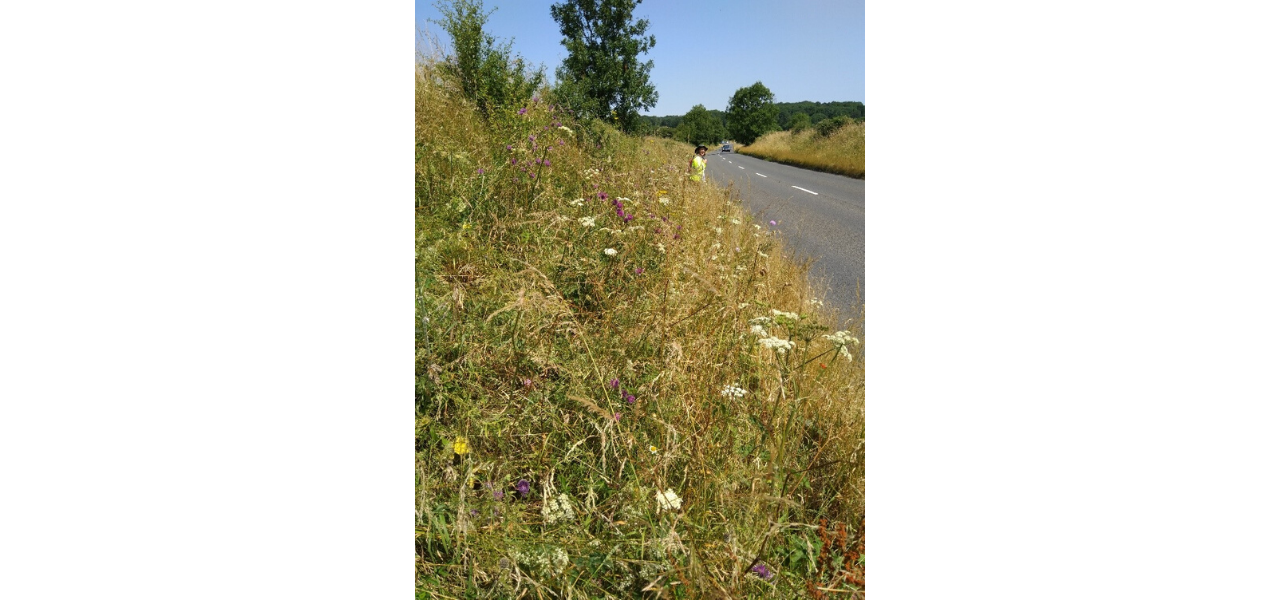Protected road verges in Wiltshire

Roadside verges strewn with wildflowers, on chalk down land and limestone grassland, are one of the distinctive aspects of the Wiltshire countryside. David White describes the Protected Road Verge (PRV) scheme.
An example of a wildflower verge project, at Wilsford in the Pewsey Vale, is described here.
Under a scheme begun in 1970 around fifty road verges throughout the county are designated as Protected Road Verges (PRVs) because of their special habitat, species or ecological interest.
Typical species-rich communities found on the chalk and limestone verges support Pyramidal and Bee orchids, Field Scabious, Rock-rose and Fairy Flax. These verges also support rich invertebrate communities including Glow-worms and many species of butterflies.
Verges on clay soils sup-port a varied neutral meadow flora including species such as Adder’s-tongue fern, Nettle-leaved Bellflower and Bath Asparagus. Ancient woodland verges in the Cotswolds in particular support a spectacular ground flora in the spring including species such as Solomon’s Seal and Fly Orchid. A verge near Chittoe supports the only Tower Mustard in the county, continually recorded there since 1670!
Unfortunately sandwiched between modern agricultural practices and heavy traffic, road verges are under threat of damage caused by vehicle parking, pollution from ve-hicle emissions, salt spray, inappropriate planting, fly tipping and herbicide drift from adjacent farmland.
How are they protected?
Verges given protected status are carefully selected and have to meet rigorous criteria. They are marked with posts at either end. Each verge has an individual management plan designed to protect and enhance its flora and fauna. Wilt-shire Council, their contractor Atkins and Wiltshire and Swindon Biological Records Centre (WSBRC) – part of Wilt-shire Wildlife Trust (WWT) work in partnership to protect and care for PRVs.
Each verge has a volunteer appointed by Wiltshire Council and the WSBRC, whose duties are to check the condition of the verge regularly and the performance of those species, communities or features for which the verge was designated. Each year these records are sent to WSBRC and Wiltshire Council to ensure the wildlife interest is maintained.
Some fifty or so road verges in Wiltshire are designated as PRVs because of the importance of their fauna, flora or geological features and are subject to special management by Wiltshire Council or the Highways Authority.
So what are the rules governing the planting up of road-side verges and roundabouts by private individuals or charitable organisations?
Unsurprisingly there is a balance to be maintained be-tween Highways safety requirements, maintenance costs and environmental gain; it’s something always at the forefront of the PRV scheme. In relation to planting up verges in private ownership, if the aim is to enhance a verge for wildlife, then the council’s ecology team would always recommend that professional advice is obtained from a professional ecologist.
All queries about the scheme should be addressed to:
Emma Glover, Landscape & Design, Economic Development & Planning, Wiltshire Council, County Hall, Bythesea Road, Trowbridge, BA14 8JN
Tel: 01225 718478
Email: emma.glover@wiltshire.gov.uk



